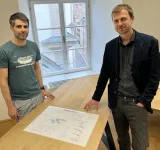(Press-News.org) Vanishing glaciers threaten alpine biodiversity
With glaciers melting at unprecedented rates due to climate change, invertebrates that live in the cold meltwater rivers of the European Alps will face widespread habitat loss, warn researchers.
Many of the species are likely to become restricted to cold habitats that will only persist higher in the mountains, and these areas are also likely to see pressures from the skiing and tourism industries or from the development of hydroelectric plants.
The research study – led jointly by the University of Leeds and University of Essex - calls on conservationists to consider new measures to protect aquatic biodiversity.
Invertebrates - key role in ecosystems
The invertebrates, which include stoneflies, midges and flatworms, play a key role in nutrient cycling and organic matter transfer to fish, amphibians, birds and mammals in the wider Alpine ecosystem.
Using glacier, landscape and biodiversity mapping data collected across the Alps, scientists from across Europe simulated how key invertebrate populations across the mountain range are likely to change between now and 2100 because of climate change.
As the climate warms, the modelling predicted the invertebrate species would seek out colder conditions in the highest parts of the mountain range. In the future, these colder areas are also likely to be prioritised for skiing or tourism or the development of hydropower plants.
Lee Brown, Professor of Aquatic Science at the University of Leeds who co-led the research, said: “Conservationists need to be thinking about how protected area designations must evolve to take into account the effects of climate change.
“It may be that some species will have to be moved to refuge areas if we want to safeguard their survival as many of them are not strong fliers so they cannot disperse easily through the mountains.”
The research paper - “Glacier retreat reorganises river habitats leaving refugia for Alpine invertebrate biodiversity poorly protected” - is published today (May 4) in the scientific journal Nature Ecology and Evolution. (The paper will be live on the Nature Ecology and Evolution website at this link when the embargo lifts: https://www.nature.com/articles/s41559-023-02061-5)
Alpine climate is changing rapidly
The research, involving a collaboration between nine European research institutions, brought together data on invertebrate species distribution in the Alps, an area that covers more than 34,000 square kilometres, and mapped it alongside expected changes to glaciers and river flows.
There was sufficient data to model what was likely to happen to 19 invertebrate species, mainly aquatic insects, that live in the cold-water regions of the Alps.
Dr Jonathan Carrivick, from the School of Geography at Leeds who co-led the research, said: “We have quantified that as glaciers melt and retreat, the rivers running through the Alps will experience major changes in their water source contributions.
“In the short term, some will carry more water and some new tributary rivers will form, but over several decades from now - most rivers will become drier, flow slower and become more stable, and there could even have periods in a year when there is no water flow. Additionally, most water in Alpine rivers will also be warmer in the future.”
Losers and winners
By the turn of the century, the modelling predicts that most of the species would have experienced "consistent losses” of habitat.
Those hardest hit are expected to be the non-biting midges, Diamesa latitarsis grp., D. steinboecki, and D. bertrami; the stonefly, Rhabdiopteryx alpina; and mayfly, Rhithrogena nivata.
However, several species are expected to benefit from the habitat changes, including the flatworm, Crenobia alpina and the flat headed may fly, Rhithrogena loyolaea.
Other species would find refuge in new locations. The scientists predict the stonefly Dictyogenus alpinus and the caddisfly Drusus discolor will be able to survive in the Rhone valley in southeast France while other species will be lost from the rivers that flow into the Danube basin.
Conservation
Writing in the paper, the researchers describe the “substantial work” that is necessary to protect the biodiversity in rivers that are being fed by retreating glaciers. The locations where glaciers still exist late in the 21st century are likely to be prioritised for hydropower dam construction and ski resort development.
Dr Martin Wilkes, from the University of Essex and who co-led the research, said: “The losses we predict for Alpine biodiversity by the end of this century relate to just one of several possible climate change scenarios.
“Decisive action by world leaders to reduce greenhouse gas emissions could limit the losses. On the other hand, inaction could mean that the losses happen sooner than we predict.”
Understanding how invertebrate populations respond to climate changes is key to understanding how biodiversity in high mountainous areas can be affected, and the techniques developed in the study could be applied to other mountain environments.
The UK’s Natural Environment Research Council contributed to the funding of the study.
END
END
Vanishing glaciers threaten alpine biodiversity
2023-05-04
ELSE PRESS RELEASES FROM THIS DATE:
Neuropathic pain: The underlying mechanism and a potential therapeutic target are revealed in mice
2023-05-04
BIRMINGHAM, Ala. – Neuropathic pain — abnormal hypersensitivity to stimuli — is associated with impaired quality of life and is often poorly managed. Estimates suggest that 3 percent to 17 percent of adults suffer from neuropathic pain, including a quarter of people with diabetes and a third of people with HIV.
In a paper published in the journal Neuron, researchers report that a mechanism involving the enzyme Tiam1 in dorsal horn excitatory neurons of the spinal cord both initiates and maintains neuropathic pain. Moreover, they show that targeting spinal Tiam1 with anti-sense oligonucleotides injected ...
Breast cancer tumors disrupt the immune system remotely favoring their own growth
2023-05-04
Researchers at Baylor College of Medicine and collaborating institutions have identified a strategy cancerous tumors use to remotely disrupt the development of an immune response that could stop their growth.
Published in the journal Cell Stem Cell, the study shows in animal models that breast cancer tumors send molecular signals to the bone marrow, the birthplace of immune cells. The signals alter the natural environment of the bone marrow in such a way that it suppresses the response to fight back the tumor. Interestingly, ...
Young men at highest risk of schizophrenia linked with cannabis use disorder
2023-05-04
Young men with cannabis (marijuana) use disorder have an increased risk of developing schizophrenia, according to a study led by researchers at the Mental Health Services in the Capital Region of Denmark and the National Institute on Drug Abuse (NIDA) at the National Institutes of Health. The study, published in Psychological Medicine, analyzed detailed health records data spanning 5 decades and representing more than 6 million people in Denmark to estimate the fraction of schizophrenia cases that could be attributed ...
Adherence to lifestyle recommendations and breast cancer recurrence prevention
2023-05-04
About The Study: In this observational study of 1,340 women with high-risk breast cancer, strongest collective adherence to cancer prevention lifestyle recommendations was associated with significant reductions in disease recurrence and mortality. Education and implementation strategies to help patients adhere to cancer prevention recommendations throughout the cancer care continuum may be warranted in breast cancer.
Authors: Rikki A. Cannioto, Ph.D., Ed.D., of the Roswell Park Comprehensive ...
Association of biomarker-based AI with risk of racial bias in retinal images
2023-05-04
About The Study: Results of this diagnostic study including 4,095 retinal fundus images collected from 245 neonates suggest that it can be very challenging to remove information relevant to self-reported race from fundus photographs. As a result, AI algorithms trained on fundus photographs have the potential for biased performance in practice, even if based on biomarkers rather than raw images. Regardless of the methodology used for training AI, evaluating performance in relevant subpopulations is critical.
Authors: J. ...
Cellular traffic controllers caught managing flow of signals from receptors
2023-05-04
Proteins that act like air traffic controllers, managing the flow of signals in and out of human cells, have been observed for the first time with unprecedented detail using advanced microscopy techniques.
Described in new research published today in Cell, an international team of researchers led by Professor Davide Calebiro from the University of Birmingham has seen how beta-arrestin, a protein involved in managing a common and important group of cellular gateways, known as receptors, works.
Beta-arrestin is involved in controlling the activity of G protein-coupled receptors (GPCRs) which are the largest group of receptors ...
Gene Tiam1 orchestrates the development of chronic neuropathic pain
2023-05-04
Neuropathy is a type of chronic pain triggered by nerve injury or certain diseases. It affects millions of people worldwide, significantly deteriorating their quality of life. Neuropathy, for example, might emerge from hurting the sciatic nerve on the lower back or the spinal cord, in diseases like rheumatoid arthritis and diabetes or after chemotherapy drugs. Current therapies attempt to suppress the symptoms with pain medications like opioids, but their efficacy is low, and they carry undesirable side effects.
A group led by researchers at Baylor College of Medicine and University of Alabama at Birmingham took on the challenge of investigating the process ...
The future of data storage lies in DNA microcapsules
2023-05-04
Storing data in DNA sounds like science fiction, yet it lies in the near future. Professor Tom de Greef expects the first DNA data center to be up and running within five to ten years. Data won’t be stored as zeros and ones in a hard drive but in the base pairs that make up DNA: AT and CG. Such a data center would take the form of a lab, many times smaller than the ones today. De Greef can already picture it all. In one part of the building, new files will be encoded via DNA synthesis. Another part will contain large fields of capsules, each capsule packed with a file. A robotic arm will remove a capsule, read its contents and place it back.
We’re talking about synthetic ...
Quantum computer in reverse gear
2023-05-04
Today's computers are based on microprocessors that execute so-called gates. A gate can, for example, be an AND operation, i.e. an operation that adds two bits. These gates, and thus computers, are irreversible. That is, algorithms cannot simply run backwards. “If you take the multiplication 2*2=4, you cannot simply run this operation in reverse, because 4 could be 2*2, but likewise 1*4 or 4*1,” explains Wolfgang Lechner, professor of theoretical physics at the University of Innsbruck. If this were possible, however, it would be feasible ...
Seizure discoveries advance efforts to develop better treatments
2023-05-04
New University of Virginia School of Medicine insights into how the brain responds to seizures could facilitate the development of much-needed treatments for the third of patients who don’t respond to existing options.
The research, from the labs of UVA’s Ukpong B. Eyo, PhD, and Edward Perez-Reyes, PhD, suggests that immune cells called microglia play important, beneficial roles in controlling various types of seizures. Prior research had left scientists uncertain whether these cells were helpful or harmful during the brain’s ...





